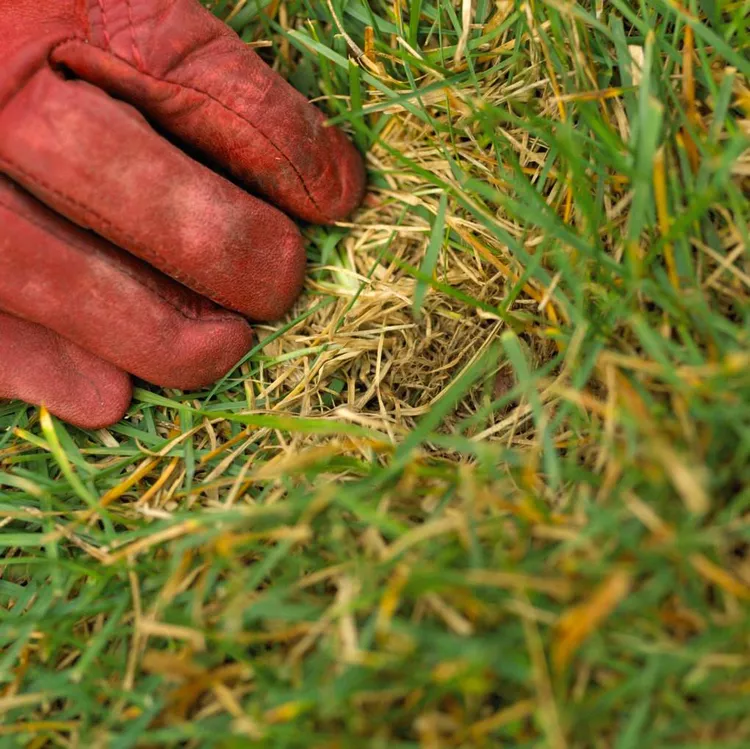What Every Homeowner Needs to Know About Dethatching Lawns

Thatch is a matted layer of grass stems, roots, stolons, rhizomes, and other organic debris that builds up faster than it can decompose. Thatch accumulates immediately below the green surface of the lawn—on top of the soil at the base of the blades. A layer of thatch less than ½ inch thick is normal and isn't cause for action. A thin layer of thatch is a good thing; it reduces soil compaction and increases tolerance for cold and heat by protecting the crown (the point on the plant where grass growth originates). Thatch also reduces water loss through evaporation.
If the thatch is more than ½ inch thick, it may cause trouble, and it might be time to dethatch the lawn. Think of it as a layer of plastic wrap on top of the soil. Your grass won't have access to air, water, or nutrients because thatch blocks them from reaching the roots. A thick layer of thatch can harbor disease-causing insects and fungi, prolong high humidity that promotes disease, and bind or tie up pesticides. As thatch builds, grass roots knit into the thatch layer instead of the soil, where they easily succumb to environmental stresses such as prolonged periods of hot, dry weather.
What Causes Thatch?
There are numerous causes for excessively thick thatch. The most common ones are:
- Poorly aerated soil.
- Excess nitrogen, which leads to excessive growth.
- Too much water, which reduces the amount of oxygen in the soil.
- Overzealous use of pesticides that kill earthworms and microorganisms that break down organic matter.
Some lawn grass varieties are more prone to developing thatch than others. For example, among the cool-season grass species, Kentucky bluegrass is a prime offender for spreading aggressively and accumulating thatch. Tall fescue may be a better choice for avoiding thatch. Bermudagrass is more likely to accumulate thatch than zoysiagrass among the warm-season grass species. Check with your local cooperative extension service to better understand the grass species that work in your area.
There are multiple ways to determine if your lawn has a thatch problem. The easiest is to check to see if your lawn is green on top but brown below. The best time to check is after you mow when you've just cut off the top green growth. If you have thatch, the lawn will look brown or dead. Another test is to walk across the lawn: If it feels spongy, it may be due to thatch.
If you're still unsure, use a spade or knife to cut several small plugs from the lawn. Measure the thatch, which appears as a layer of spongy brown material between the grass and the soil. Dethatching lawns is in order if the thatch is more than ½ inch deep.
When Is the Best Time for Dethatching Lawns?
Dethatching lawns should only be done when conditions are best to promote rapid recovery of your grass type. The best time to dethatch cool-season lawns is late August to early October, depending on your location, when the grass grows vigorously and few weed seeds are likely to germinate. A light application of fertilizer (½ to ¾ pound actual nitrogen per 1,000 square feet) and regular, deep watering will speed the lawn's recovery.
Dethatch warm-season lawns in late spring or early summer after they are completely green and growing rapidly.
How Do I Dethatch My Lawn?
There are several ways of dethatching lawns. For lawns with moderate levels of thatch, aerating may do the trick. Or use a cavex rake (also known as a thatching or lawn dethatcher rake) with unusual semicircular tines. Those knifelike blades cut through the sod and pull out the thatch. The most effective solution for dethatching lawns that are large and have serious thatch problems is a vertical mower (power rake). Resembling a heavy-duty power mower but with a series of spinning vertical knives, it cuts through the thatch.
Dethatching often creates a large volume of debris that must be removed. If the debris is weed-free and you have not used herbicides or pesticides on your lawn, compost it. You can also check to see if your city has a composting program for yard waste.
How Do I Reduce Future Thatch Accumulation?
Thatch is inevitable, but appropriate lawn care practices will reduce the severity in the future. Use the right type and amount of fertilizer for normal growth. Water deeply and thoroughly, but infrequently. Maintain proper pH levels for your grass type and adjust them if needed. Aerate your lawn regularly to make room for new growth.
How Do I Aerate My Lawn?
The roots of all plants need air as much as water, which is why aerating your lawn is so important. It's a simple process of perforating the soil (and any thatch) while removing plugs of lawn that leave behind small holes that allow water, air, and fertilizer to get to roots. Aeration enables the roots to grow deeply, producing a more vigorous lawn.
The best time to aerate cool-season lawns is late August through early October. The second best time is in the spring. (Wait until you've mowed the lawn twice before aerating in spring.) Follow with regular, frequent watering. The best time to aerate warm-season lawns is in late spring or early summer—or anytime followed by four weeks of good growing weather. Lawns with severe thatch problems may need twice-yearly aeration.